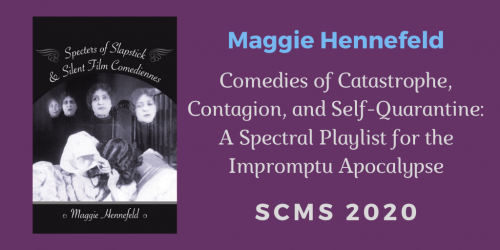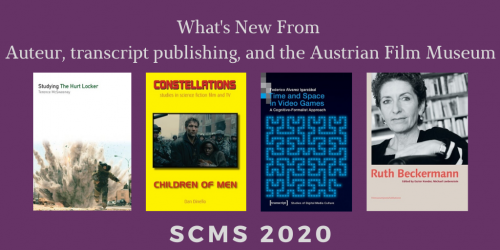There’s More to 3D Than Meets the Eye
By Nick Jones

“This book’s highly polished arguments situate digital 3D cinema within major debates about the role of the image in contemporary society as well as related structures of power. Jones’s historical focus and interaction with significant visual culture debates situate the unique contribution this book has to offer.”
~Miriam Ross, author of 3D Cinema: Optical Illusions and Tactile Experiences
The following is a post from Nick Jones, author of the just-published Spaces Mapped and Monstrous: Digital 3D Cinema and Visual Culture. Though the clips don’t allow for the full 3D experience, they do highlight the surprisingly diverse possibilities of the technology.
• • • • • •
Relatively few people see 3D as a vital or creatively exciting aspect of contemporary cinema. The format may have a long history but is nonetheless dismissed as somehow separate from or even anathema to true cinema. However, as I argue in Spaces Mapped and Monstrous: Digital 3D and Visual Culture, commercial narrative feature films that are released in stereoscopic 3D represent significant evidence of broader changes to visuality in the digital era. As a result, these films need to be taken seriously: 3D is not a novelty or a gratuitous effect but a fundamental aspect of today’s visual culture. And if we give 3D its due, we can reveal the diverse creative opportunities offered by the format.
This goes far beyond objects lunging out at the viewer or even the more critically appreciated depiction of spacious landscapes. The struggle for widespread acceptance of 3D among casual viewers and even parts of the film industry means that the extent of its aesthetic potential is rarely fully appreciated. This is a shame. Also unfortunate is the rather limited canon of films that are usually discussed in relation to the medium: 3D is more than just ten-foot blue Pandorans, after all.
While my book attempts to map the importance of digital 3D cinema to larger issues in a more scholarly manner, I write this blog post as a fan of 3D and an advocate of the possibilities it offers to filmmakers. Trips to the cinema, like all other cultural activities, may be impossible right now, but here I recommend five films that have not been given their due as stereoscopic entertainments and that, for me, indicate something of the exciting ways in which 3D is used by filmmakers.
Paranormal Activity: The Ghost Dimension (2013)
In this sixth entry, the Paranormal Activity franchise aimed to freshen the formula by using 3D for the first time. A found-footage film, The Ghost Dimension has its hapless protagonists find an analog video camera somehow endowed with the unique ability to capture the ghosts haunting their large home in the Californian suburbs. Indeed, it is only when ghosts appear that the film switches from 2D to 3D, the screen expanding slowly, ominously, threateningly—as though the film frame needed to create a new kind of space to accommodate its strange, malevolent spirits. Equating the titular “ghost dimension” with 3D, the film points to the disturbing, nonhuman qualities of this medium.
Resident Evil: Retribution (2012)
Another franchise that took to 3D partway through its run (and that also has a reputation as far from high art), this video game adaptation nonetheless provides some inspired indication of how 3D and action can work in harmony. At times this involves slightly lengthy takes and slow motion, but the film consistently uses careful framing to place the contents of a shot at various depth planes, and takes subtle pleasure showing the repositioning of things in space—in particular during fight scenes. A highlight is a fight between the protagonist, Alice, and a horde of zombies in a clean white corridor, a setting that turns the sequence into a kind of delirious 3D chess game.
In the Heart of the Sea (2015)
A rare flop from director Ron Howard, this adaptation of the events that inspired the novel Moby-Dick offers a sweaty, heady vision of nineteenth-century whaling. Like the contemporaneous 3D releases Billy Lynn’s Long Halftime Walk (2016) and One More Time with Feeling (2016), In the Heart of the Sea places the viewer in extreme, intimate proximity to its characters and world, the vivid colours and framings of Anthony Dod Mantle’s cinematography becoming a flood of layered, intensely immediate spatial imagery.
Godzilla (2014)
As I discuss in Spaces Mapped and Monstrous, miniaturization is a frequent side effect of digitally converted 3D, especially in major blockbusters. Depicting city-leveling threats and 200-foot-tall monsters, these films struggle to reconcile palpable 3D cues (justifying the inclusion of the format) with the scale of their spectacle (which, because of their size and distance, wouldn’t involve strong binocular depth if observed in real life). The U.S. film that launched Legendary Entertainment’s Monsterverse, Godzilla shows how this can be an asset rather than a liability, as miniaturization gives weight and shape to the massive monsters even as it makes the scurrying, tiny human characters appear all the more inconsequential.
Let Your Light Shine (2013)
In this abstract short, the experimental filmmaker Jodie Mack explores the psychedelia of anaglyph 3D— – if you have a pair of red/cyan glasses, you can enjoy it on any screen. For three minutes, Mack creates three-dimensional splinters of light and line, a shimmering kaleidoscopic slide show testifying to the potential of even the simplest 3D to alter perception and render space and vision something new, strange, even incomprehensible.








